duet
Haydn - Adagio from Sym. No.24 - Flute & Piano
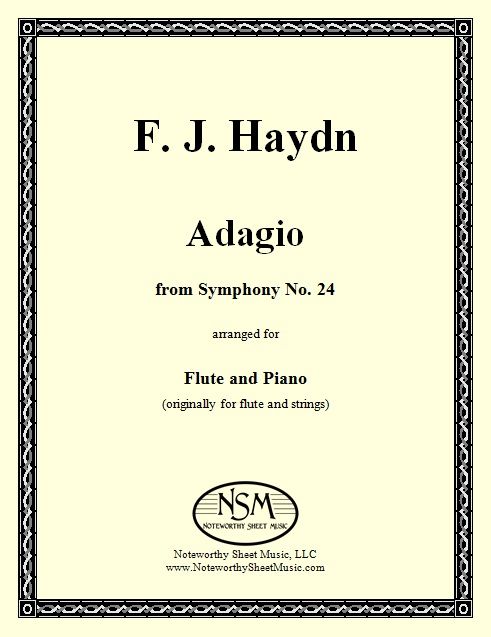 Adagio from Symphony No. 24, by F. J. Haydn
Adagio from Symphony No. 24, by F. J. Haydn
Arranged for Flute and Piano by John W. Pratt
Flute Part and Piano Score, PDF $6.00
Franz Joseph Haydn (1732-1809) wrote his Symphony No. 24 in 1764. The second movement is a beautiful Adagio for solo flute accompanied by strings, with a place for a cadenza. We offer here a piano transcription of the string accompaniment, with appropriate adaptations in sonority, and the flute part with a written cadenza based closely on Haydn's material and style. Players will find the resulting one-movement flute sonata both affecting and highly rewarding.
Flute part, 2 pages; Flute & Piano score, 4 pages; Total, 10 pages.
Preview======================================================
We also offer a professionally-printed hard copy edition of the Haydn Adagio for $13.49 plus a $5.95 shipping and handling fee. Due to prohibitively high international shipping rates, we ship print editions only to addresses in the USA. Please use the Contact Us form to let us know which hard copy publication(s) you would like to purchase, along with your email contact information and USPS mailing address. We will then send you a PayPal invoice for the sale and, once we receive notice from PayPal that you have paid for the item(s), we will ship your music to the address provided for delivery in 7-10 business days.
Haydn - Adagio, Quartet Op.17, No.1 - Afl & Pf
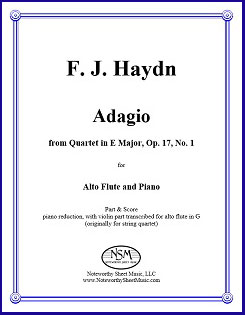 Adagio from Quartet in E Major, Op.17, No.1, by F. J. Haydn
Adagio from Quartet in E Major, Op.17, No.1, by F. J. Haydn
Transcribed for Alto Flute and Piano by John W. Pratt
Alto Flute Part and Piano Score, PDF $8.00
Haydn's early quartets, especially the three sets of six written between 1768 and 1771 (Opus 9, Opus 17, and Opus 20), advanced the development of the classical string quartet enormously in all respects. The third movement of Opus 17, No. 1 is an Adagio with a beautiful violin melody that is harmonized simply by the other three strings. Whereas Haydn's more complex movements generally are unsuitable for transcription, the relative simplicity of this gorgeous Adagio makes it an exception. We present here a transcription for alto flute and piano. The melody is highly effective on the alto flute, and the other string parts are readily adaptable to the piano.
Alto Flute part, 2 pages of music; Piano score, 6 pages; Total, 12 pages.
PreviewHaydn - Adagio, Quartet Op.17, No.2 - Afl & Pf
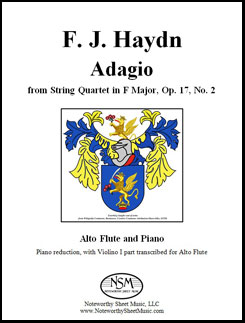 Adagio from Quartet in F Major, Op.17, No.2, by F. J. Haydn
Adagio from Quartet in F Major, Op.17, No.2, by F. J. Haydn
Transcribed for Alto Flute and Piano by John W. Pratt
Alto Flute Part and Piano Score, PDF $8.00
The third movement of Haydn's Opus 17, No. 2, like that of Opus 17, No. 1, is an Adagio with a beautiful violin melody that is harmonized simply by the other three strings. The melody is compelling on alto flute, with just a few changes to accommodate its sonic differences from the violin. Lest the effect be too placid when the lower string parts are transferred to the piano, our piano transcription elaborates them in the style of Haydn's keyboard music in several places. We also incorporate a few changes for better sonority and to disentangle the voices where the string parts have overlaps and unisons that are poorly suited to the piano. All told, this transcription is highly effective and a delight for both players.
Alto Flute part, 2 pages of music; Piano score, 6 pages of music; Total, 12 pages.
PreviewHaydn - Adagio, Quartet Op.20, No.5 - Fl & Pf
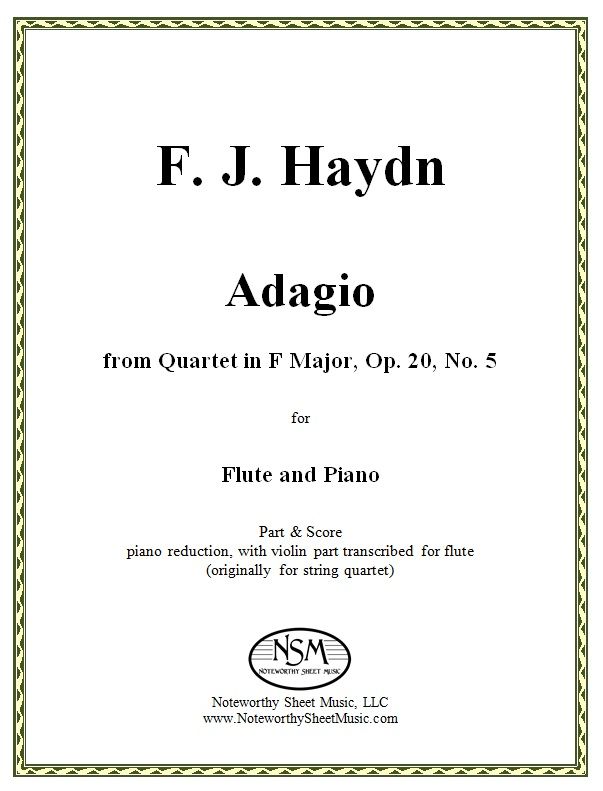 Adagio from Quartet in F Major, Op.20, No.5, by F. J. Haydn
Adagio from Quartet in F Major, Op.20, No.5, by F. J. Haydn
Arranged for Flute and Piano by John W. Pratt
Flute Part and Piano Score, PDF $10.00
The third movement of Haydn's string quartet Opus 20, No. 5 is an Adagio with a simple melody that is treated to delightful filigreed elaboration and obbligato decoration by the violin. Although more complex quartet movements are typically unsuited to transcription, in this beautiful Adagio the soloistic nature of the violin part and the simplicity of the lower string parts lend themselves very well to an arrangement for flute and piano, as in the fine transcription we offer here.
Flute part, 3 pages of music; Piano score, 7 pages of music; Total, 14 pages.
PreviewHaydn - Early Sonatas - arr. as Wind Duos
 Early Sonatas, by Franz Joseph Haydn
Early Sonatas, by Franz Joseph Haydn
Arranged as Woodwind Duets by John W. Pratt (originally for keyboard)
Even the earliest of Franz Joseph Haydn’s keyboard sonatas have great rhythmic variety and vitality, and are delightful when played with verve. They are mostly in two voices, and even where not, their early classical harmonies are easily conveyed by two instruments. They incorporate few pianistic effects and lie comfortably within range for flute or oboe and bassoon or clarinet, and thus make natural woodwind duets of lively, interesting music. All these editions include a score and parts. Those wishing to consult the keyboard editions of the Haydn sonatas, from which Mr. Pratt created his arrangements, can find them at imslp.org. (Adapted from J. W. Pratt’s preface to the edition.)
Cover image “Decorations of the Sala Terrena, Eszterházy Palace in Fertőd, Hungary“ by Monyesz, Creative Commons Attribution-Share Alike 3.0 Unported license.
--------------------------------------------------------------------------------
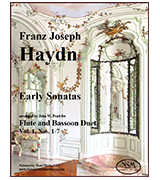 This edition includes seven of Haydn's early keyboard sonatas arranged as duets for flute and bassoon. John Pratt's creation of these duets was inspired by a desire to offer two of his music colleagues some new music to enjoy, as they had exhausted their available flute and bassoon duo repertoire. These duets work nicely for winds and are fun to play. For a sense of how they sound when played by flute and bassoon, click below to listen to a computer-generated audio excerpt: the first 45” of the recording come from the Andante of Sonata 5 (Hob. XVI:11), followed by 25” of the Sonata 6 (Hob. XVI:10) Presto. Alternatively, the flute part can be played on oboe, making these sonata arrangements nicely amenable to oboe and bassoon duos as well.
This edition includes seven of Haydn's early keyboard sonatas arranged as duets for flute and bassoon. John Pratt's creation of these duets was inspired by a desire to offer two of his music colleagues some new music to enjoy, as they had exhausted their available flute and bassoon duo repertoire. These duets work nicely for winds and are fun to play. For a sense of how they sound when played by flute and bassoon, click below to listen to a computer-generated audio excerpt: the first 45” of the recording come from the Andante of Sonata 5 (Hob. XVI:11), followed by 25” of the Sonata 6 (Hob. XVI:10) Presto. Alternatively, the flute part can be played on oboe, making these sonata arrangements nicely amenable to oboe and bassoon duos as well.Preview: Vol.1, Nos. 1-7, Flute and Bassoon
--------------------------------------------------------------------------------
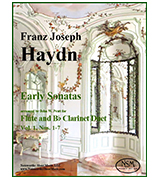 ►Early Haydn Sonatas arranged by John W. Pratt as Duets for Flute and B-flat Clarinet, Vol. 1, Nos. 1-7
►Early Haydn Sonatas arranged by John W. Pratt as Duets for Flute and B-flat Clarinet, Vol. 1, Nos. 1-7
Preview: Vol.1, Nos. 1-7, Flute and Clarinet
Haydn - Fantasia in C Major - Flute & Alto Flute
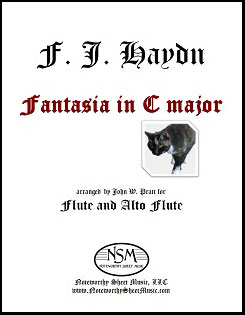 Fantasia in C major, by F. J. Haydn
Fantasia in C major, by F. J. Haydn
Arranged as a Duet for Flute and Alto Flute by John W. Pratt
Flute Part, Alto Flute Part, and Score ― PDF $12.99
Fantasia in C major (Op.58; Hob. XVII:4) was written by Haydn in 1789 for the pianoforte. Based on a folk song about a farmer's wife chasing her cat, one can easily imagine in the music kittenish scampering, stealthy approaches, unexpected pounces, and mad chases with abrupt changes of direction. The style and playfulness of the piece are beautifully suited to the agility and sparkle of flutes. The transcription is able to capture the feel Haydn intended, with new coloring, while at the same time affording flutists the joy of experiencing the work first-hand. (adapted from JWP's foreword to the edition)
Please click the Preview button to see p1-2 of the mini-Score (in concert pitch). After opening the file, adjust the orientation using "View - Rotate View - Clockwise" in your pdf reader program.
Flute part, 6 pages; Alto Flute part, 7 pages; Mini-score, 6 pages; Total, 22 pages.
PreviewHaydn - Fantasia in C Major - Flute & Clarinet
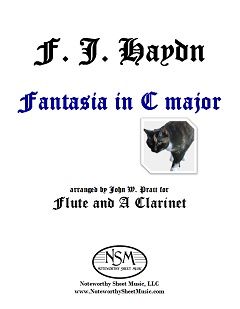 Fantasia in C major, by F. J. Haydn
Fantasia in C major, by F. J. Haydn
Arranged as a Duet for Flute and Clarinet by John W. Pratt
Flute Part, A Clarinet Part, and Mini-Score ― PDF $12.99
Fantasia in C major (Op.58; Hob. XVII:4) was written by Haydn in 1789 for the pianoforte. Based on a folk song about a farmer's wife chasing her cat, one can easily imagine in the music kittenish scampering, stealthy approaches, unexpected pounces, and mad chases with abrupt changes of direction. The style and playfulness of the piece lend themselves well to flute and clarinet. The transcription is able to capture the feel Haydn intended, with new coloring, while at the same time affording flutists and clarinetists the joy of experiencing the work first-hand. (adapted from JWP's foreword to the edition)
Flute part, 6 pages; Clarinet in A part, 6 pages; Mini-score in concert pitch, 6 pages; Total, 24 pages.
PreviewHerman - Grands Duos Concertantes - Two Flutes
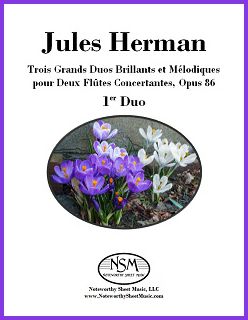 Trois Grands Duos Brillants et Mélodiques pour Deux Flûtes Concertantes, by Jules Herman
Trois Grands Duos Brillants et Mélodiques pour Deux Flûtes Concertantes, by Jules Herman
New Editions by Noteworthy Sheet Music, with a Foreword by P. H. Bloom
Duo 1: Flute 1 Part, Flute 2 Part, and Mini-Score ― PDF $17.98
Duo 2: Flute 1 Part, Flute 2 Part, and Mini-Score ― PDF $21.75
Duo 3: Flute 1 Part, Flute 2 Part, and Mini-Score ― PDF $17.98
Jules Herman's Grands Duos Concertantes (Opus 86) are works of ingenuity, charm, brilliance, grace, and humor. Long overlooked, they are extraordinarily fine examples of concert-worthy duets of the late 19th century. Originally published by Choudens in Paris about 1885, the Grand Duos were dedicated to composer François-Auguste Gevaert (1828–1908), then director of the Royal Conservatory of Brussels. Flutists will find these works challenging and rewarding, teachers of advancing students will be amazed by their utility, and audiences will be enchanted. (excerpted from PHB's © foreword)
Note that these duets make for excellent sight-reading training ... the music is interesting and demanding, and the parts are nicely balanced. All three duets have three movements each. Duo 1: Allegro moderato; Adagio sostenuto; and Rondo allegro. Duo 2: Moderato; Scherzando; and Polonaise. Duo 3: Allegretto vivace con brio; Air Varié, Andante; and Boléro, Moderato.
Hewitt - Trip to Nahant - Flute + Clarinet
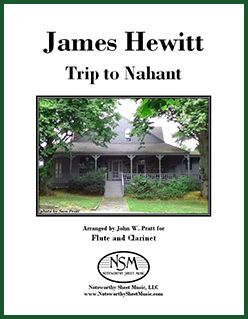 Trip to Nahant, by James Hewitt
Trip to Nahant, by James Hewitt
Arranged as a Duet for Flute and Clarinet by John W. Pratt
Flute Part, Bb Clarinet Part, alternate A Clarinet Part, and Score ― PDF $5.99
James Hewitt (1770-1827) moved from London to New York in 1792 and was active in both New York and Boston as a composer, arranger, music publisher, performer, teacher, and orchestra conductor. In Hewitt's time, Nahant was an island connected to the mainland by a sandbar submerged at high tide, now a causeway. It was a popular, cool place for day trips from Boston and later became a fashionable summer resort.
Hewitt's Trip to Nahant, a favorite Rondo (1811) was written for keyboard, and is typical of American music of the period. It is charming, light in texture and subject, and well suited to arrangement for flute and clarinet. (adapted from JWP's foreword to the edition) We provide parts for Flute and Clarinet in Bb, along with an alternative part for Clarinet in A and a Score in concert pitch.
Flute part, 2 pages; Bb Clarinet part, 2 pages; alternate A Clarinet part, 2 pages; Score, 4 pages; Total, 16 pages.
PreviewKalliwoda - Concertino - Alto Flute
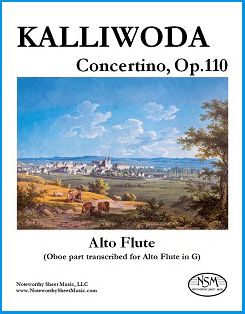 Concertino, Op.110, by J. W. Kalliwoda
Concertino, Op.110, by J. W. Kalliwoda
Transcribed for Alto Flute by C.A.Vater
Alto Flute Part ― PDF $6.99
Johann Wenzel Kalliwoda (1801‒1866) was a Bohemian violinist, orchestra conductor, and prolific composer who wrote numerous compositions, including operas, symphonies, various works for violin and orchestra, piano pieces, and chamber music works. He was considered a significant composer in his day, especially for pieces written early in his career, and his music received the praise of Robert Schumann. Kalliwoda was immensely popular and a favorite of American concert-going audiences in the first half of the 19th century.
His Concertino, Op.110, for oboe and orchestra was first published by Schott in 1841. An arrangement of the work for oboe and piano is available on imslp.org, in addition to an orchestral score and parts for oboe, violins I and II, violas, cellos, and basses. Like many of Kalliwoda's earlier compositions, the Concertino is highly melodic and energetic. We created a transcription of the solo oboe part for alto flute that gives alto flutists an opportunity to experience first-hand the joy of playing this style of classical 19th century bravura work, for which the alto flute is well-suited. Perhaps it should be pointed out that Theodore Boehm, who developed the modern alto flute in G during the mid-1850's, intended that the alto become a new instrument in its own right, utilized in a variety of musical roles and characterized by a unique quality of sound. Indeed, we think Boehm likely would have approved of our creating new opportunities, such as this transcription of the Kalliwoda Concertino, to show off the alto flute's versatility and the alto flute performer's virtuosity.
We provide our alto flute part only; appropriate parts for piano or orchestral accompaniment may be obtained as free pdf downloads from public domain resources, such as imslp.org.
Alto Flute part, 7 pages; Total, 10 pages.
Preview